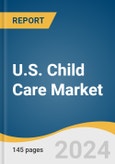In February 2023, a new child care bill was proposed by lawmakers of the Biden government. The bill is expected to make child care more affordable for all families across the U.S. In addition, the advancement in learning technologies for children is resulting in further opportunities for the market. For instance, Starfall, one of the popular learning tools for children, is based on advanced technology allowing children to learn art, languages, and mathematics via engaging activities & games. The software and online portal are transforming the U.S. childcare market.
The COVID-19 pandemic resulted in the closure of facilities temporarily due to restrictions by the government. The services resumed shortly, despite the risk of infection involved. This resulted in higher operating costs for the service providers. According to the Center for American Progress, a nearly 47% increase in operations cost was observed in 2020. The cost of home-based services witnessed a 70% rise since the pandemic. The high cost of services has negatively impacted the market and worsened the affordability issues.
U.S. Child Care Market Report Highlights
- Based on type, the early education & daycare segment dominated the market in 2022. This can be attributed to the partnership by child development & early education centers with employers to support employee child care and the adoption of advised technology aiming at the transformation of just daycare into proper early education
- Based on the delivery type, organized care facilities dominated the market in 2022. This is due to the growing requirement for more facilities as a result of the increasing number of families with both parents working and single-parent families
- The COVID-19 pandemic has promoted home-based services, as the corporate organizations supported their employees working from home, by facilitating home-based service
- Strategic initiatives are undertaken by key players to expand their quality of service in the U.S. For Instance, in May 2022 , Bright Horizons Family Solutions, Inc., announced an agreement for the acquisition of Only About Children, a high-quality child care services provider based in Australia, aiming to apply their quality techniques in the U.S., enhancing the quality of services
This product will be delivered within 1-3 business days.
Table of Contents
Companies Mentioned
- Bright Horizons Family Solutions
- KinderCare Learning Centers LLC.
- Learning Care Group, Inc.
- Spring Education Group.
- Cadence Education
- The Learning Experience
- Childcare Network
- Kids ‘R’ Kids
- Primrose Schools Franchising SPE, LLC.
- Goddard Franchisor LLC
Methodology

LOADING...
Table Information
| Report Attribute | Details |
|---|---|
| No. of Pages | 67 |
| Published | May 2023 |
| Forecast Period | 2022 - 2030 |
| Estimated Market Value ( USD | $ 60.4 Billion |
| Forecasted Market Value ( USD | $ 83.6 Billion |
| Compound Annual Growth Rate | 4.1% |
| Regions Covered | United States |
| No. of Companies Mentioned | 10 |









